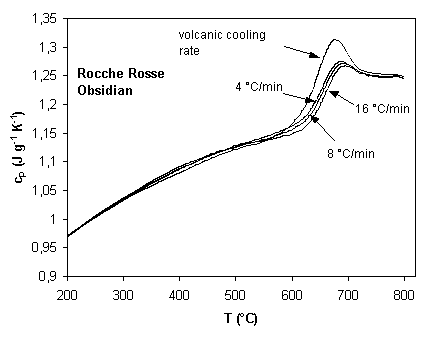

Effusive lava flows are usually rare in high silica volcanic centers showing a predominant explosive character. Due to their high silica content and hence their increased viscosity, evolved magmas tend to fragment explosively as a response to applied stress rather than forming flow-spread deposits. Nevertheless, certain chemical and physical constraints (e.g. high alkali and/or water content) may also enhance the ability of felsic magmas to form locally widespread lava flows. What, other than discharge rates, are the parameters that influence the rheology of magma to allow lava to form widespread individual rhyolitic flow deposits up to 200 km³ (e.g. Snake River Plain volcanic Province, Idaho/USA; sample 1) on the one hand and locally restricted obsidian flows that only extent for a few hundred meters (e.g. Rocche Rosse, Lipari/Italy; sample 2) on the other ?
In this study we are concentrating our investigations on a study of
the natural cooling rates of obsidian flows in order to determine what
may influence their rheology, and thus their tendency to form either widespread
or locally restricted deposits. Scanning calorimetry is being used to model
and compare natural cooling rates of the Lipari and Idaho flows. One particular
aspect is to find out whether a foamed flow surface could create an insulating
carapace and thus prevent the interior of a flow from intensive chilling
thereby allowing the lava to flow in a widespread manner. Specific heat
capacities (cp) were measured as a function of temperature by
heating the glassy flow samples at 5°/min above its glass transition
temperature (Tg, defined as the temperature of the cp-peak
value) to allow thermal equilibrium of the supercooled liquid. This gives
us the natural cooling rate cp-curve (raw curve). The calorimetric
trace of the sample in the glass transition region and Tg itself
is a function of the thermal history of the glass. By reheating the sample
at a constant heating rate of 5°C/min, after applying a set of known
cooling rates of 16°C/min, 8°C/min, 4°C/min, three different
calorimetric traces for each sample are obtained (Fig. 3.7-1) where the
influence of cooling rate on the hysteresis in the glass transition interval
is evident. The sample cooled significantly more slowly than 4°C/min.
With this full set of 5 cooling curves and the aid of a fitting procedure
(with several variable parameters) the natural cooling rate of the samples
is being determined. With the modeled cooling rates rheological constraints
on the flow behaviour of such silicic lava flows will be constrained.
 |
|

Tel: +49-(0) 921 55 3700 / 3766, Fax: +49-(0) 921 55 3769, E-mail: bayerisches.geoinstitut(at)uni-bayreuth.de
 Previous page
Previous page